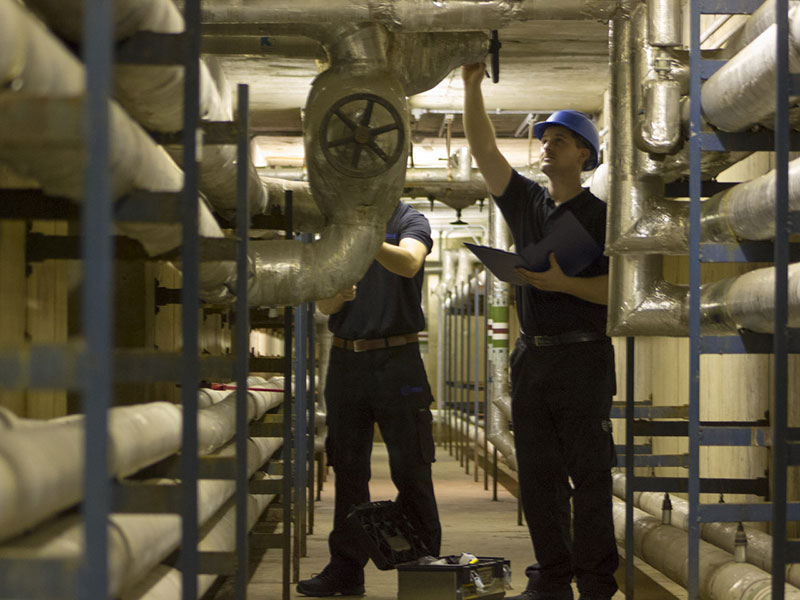How to manage asbestos in the workplace
The very name “asbestos” – referring to the naturally occurring fibrous silicate mineral – is now so synonymous with serious dangers to human health, that it might seem hard to believe it was once widely used across various industries in the UK.
Characteristics like its heat and chemical resistance made asbestos a go-to building material in the UK for much of the 20th century. However, asbestos also became notorious for the often fatal health conditions – such as mesothelioma and lung cancer – that developed in many people who ingested or breathed in the substance.
For these reasons, the use of asbestos was finally fully banned in the UK in 1999. However, the long history of the substance’s use means it remains present in many buildings up and down the country – including a significant number of workplaces.
Today, various stringent regulations exist to help ensure the owners and managers of commercial buildings take the utmost care over the risk that asbestos might pose on their premises.
If you have the legal duty to manage asbestos on your premises, you might be anxious to know how you can fulfil your obligations in this regard. So, let’s take a look at the steps you should be taking to manage asbestos in your workplace.
Whose responsibility is it to manage asbestos in the workplace?
The Control of Asbestos Regulations 2012, also known as CAR 2012, make clear that those who manage non-domestic premises also have a “duty to manage” the asbestos that may be present on those premises.
Specifically, you will be the “dutyholder” – and will therefore be responsible for managing asbestos on the given site – if you are the owner of the non-domestic premises, or the person or organisation with clear responsibility for maintaining or repairing those non-domestic premises.
Before you start, important things to remember
There are some important principles to bear in mind that should guide your decisions when you are managing asbestos in your workplace:
- Asbestos does not pose a risk to health unless it is disturbed, so a major focus of your on-site activities should be on avoiding any unnecessary disturbance
- A key principle of CAR 2012 is that if you are unsure whether a given material on your site contains asbestos, you should presume that it does
- The “duty to manage” does not require the removal of asbestos from your site. If you adopt the right measures, it is perfectly possible to leave asbestos in place and maintain safety, provided that the asbestos is in good condition and undisturbed
- If you require the services of a specialist when you are seeking to manage the asbestos on your premises, you should make sure they are technically competent.
Assess whether the property contains asbestos
There are various factors that will help you determine the likelihood of asbestos being present in the buildings for which you are responsible.
One of the most important of those factors will be the age of the building; if you know for sure that the building was constructed during or after the year 2000, it is unlikely to contain any asbestos. If, on the other hand, you know that the building was constructed prior to 2000, or you are unsure of the building’s age, you should presume it does contain asbestos unless you know for sure that it does not.
It is also worth informing yourself about some of the materials that can sometimes contain asbestos, so that you can assess the likelihood of this being the case for materials on your premises. Before it was banned in the UK in 1999, asbestos was contained in various materials commonly used in construction, such as lagging, sprayed coatings on ceilings and walls, asbestos insulating board, textured coatings, and roofing felt.
You are also advised at this stage to seek out as much information as you can about any previous asbestos records for your premises. You might be able to obtain copies of reports or plans related to your buildings.
If you can, it is also a good idea to ask the previous owners or tenants of the building about any asbestos on the site that they might know about. You might also approach the facilities management company if there is one, and even the building architect, designer, or builder.
Arrange for an asbestos survey to be carried out
Now, it will be time for you to organise an inspection of the building in search of asbestos.
As we have previously outlined in the Learning Centre here at Oracle Solutions, the broad purpose of an asbestos survey is to find out information about the asbestos that might be present on your site. Such information will include whether asbestos is present on the site at all – and if it is, the location of that asbestos, as well as its amount and condition.
Learning these details about the asbestos-containing materials (ACMs) on your site will allow you to take further proactive steps to manage the asbestos. One such step should be the production of an asbestos register showing exactly where the materials can be found on your premises.
An asbestos register is a document that shows the results of an asbestos survey on a given premises. It should contain a comprehensive list of all the ACMs found in the building, as well as information about the quantity and condition of those ACMs.
Review the asbestos report and determine the next steps
Once you have the results back from the asbestos survey, you will need to review the findings in the report, and use this information to decide how you will manage any asbestos materials found on your site.
For each entry in your asbestos register, you will need to set a material score and a priority score. The material score will be determined by the type of material present, while the priority score will set out the level of urgency applicable to management of the material. The exact priority score you give, then, will depend on factors including the material’s location and condition.
If the given asbestos material is in good condition, you should set a score of 1 for both material and priority. If the material is in poorer condition, the UK Health and Safety Executive (HSE)’s material and priority scoring tool will help you to set suitable scores.
You should record the scores for each asbestos material in your asbestos register.
Write up an asbestos management plan
As the dutyholder for your workplace under CAR 2012, it will be your responsibility to prepare a plan that outlines in detail how you will manage the risks posed by any asbestos found on your premises.
You will need to write an asbestos management plan before you arrange for any work to be done on your site. It should include:
- Who is responsible for managing the asbestos on your site;
- The asbestos register that you have just put together;
- Plans for work on asbestos materials;
- The schedule for monitoring the condition of asbestos materials on your site; and
- Telling people about your decisions in relation to the management of asbestos.
Your asbestos management plan must be easy to find, read, and update. It can also be written or take the form of a computer-based record. Feel free to consult our previous article setting out what you need to know when creating an asbestos management plan.
If work is being carried out to the building, test for asbestos
Before you undertake any work on your premises that could disturb asbestos materials, you must either:
- Arrange for an expert to help you test whether asbestos is present or absent on your site; or
- Put in place full asbestos safety precautions for the work.
If you aren’t planning to carry out any such work at your buildings, it won’t be necessary to test for asbestos. In the event, however, that you do intend to undertake work at your site, the testing for asbestos will enable you to determine whether asbestos is present in the area where you will be carrying out the work.
If you are looking to test for asbestos on your premises, our advice would be to consult a UKAS-accredited asbestos specialist, such as Oracle Solutions. We would also advise you against taking any samples for testing yourself.
When you do approach an asbestos surveyor about testing for asbestos in readiness for work to be carried out on your site, they are likely to recommend one of two types of asbestos survey: a refurbishment survey, or a demolition survey.
Ensure good communication with others
A high standard of communication with others is crucial when you are managing asbestos at your workplace. Telling other people about what you are doing to manage asbestos will help ensure the safety of people who could otherwise be at risk of coming into contact with the ACMs on your premises.
You should certainly be telling employees at your workplace about your findings and decisions, in addition to training your maintenance workers to ask about asbestos for every job. You should also ensure everyone is aware of how to report problems, so that you can remedy any defects.
It is crucial that you warn anyone who is set to work on the fabric of your building about any ACMs that are present. Examples of such people who could otherwise cause disturbance to asbestos materials on your site include builders, roofers, painters, decorators, plumbers, electricians, and repairers.
Getting work done
There are several more broad principles that you should keep closely in mind when managing the asbestos at your workplace:
- Don’t try to work directly on asbestos at your site yourself – instead, ensure that UKAS-accredited, licensed professionals carry out this work.
- You must ensure you choose a suitably qualified, skilled, and experienced asbestos professional. You can help ensure this by choosing an asbestos surveying company that holds UKAS accreditation to ISO/IEC 17020, which will indicate that they have the technical competence to undertake a high standard of asbestos inspections at sites like yours.
Keep records up to date
The safe and effective management of asbestos at your workplace will not be a one-off act. The right ongoing processes will be needed, including always keeping your records up to date.
- You should be arranging to check ACMs on your site at least once a year, to ensure they haven’t deteriorated.
- You should also be checking against the asbestos register and identifying who is going to undertake such checks, when they will do so, and why they are able to do this work – for example, because they have the necessary training.
- Finally, you should be updating your asbestos management plan where necessary in response to any changes.
Here at Oracle Solutions, we stand ready to assist if you require advice and help in relation to the above processes. Call us today or send us an email, to request a free and fast quotation for the service you require from our UKAS-accredited asbestos consultants.

Written by Jess Scott
Jess Scott has been an all-round asbestos consultant since 1996. That’s nearly 3 decades of asbestos knowledge. He spends his time sharing that knowledge with the team at Oracle and with their clients. Jess's goal is, and always has been, to use my expertise in helping people to comply with the law. This legal compliance ultimately helps to protect everyone from the harmful effects of asbestos. Jess has acted as an asbestos expert witness in legal cases and is involved in many asbestos educational activities throughout the UK.

